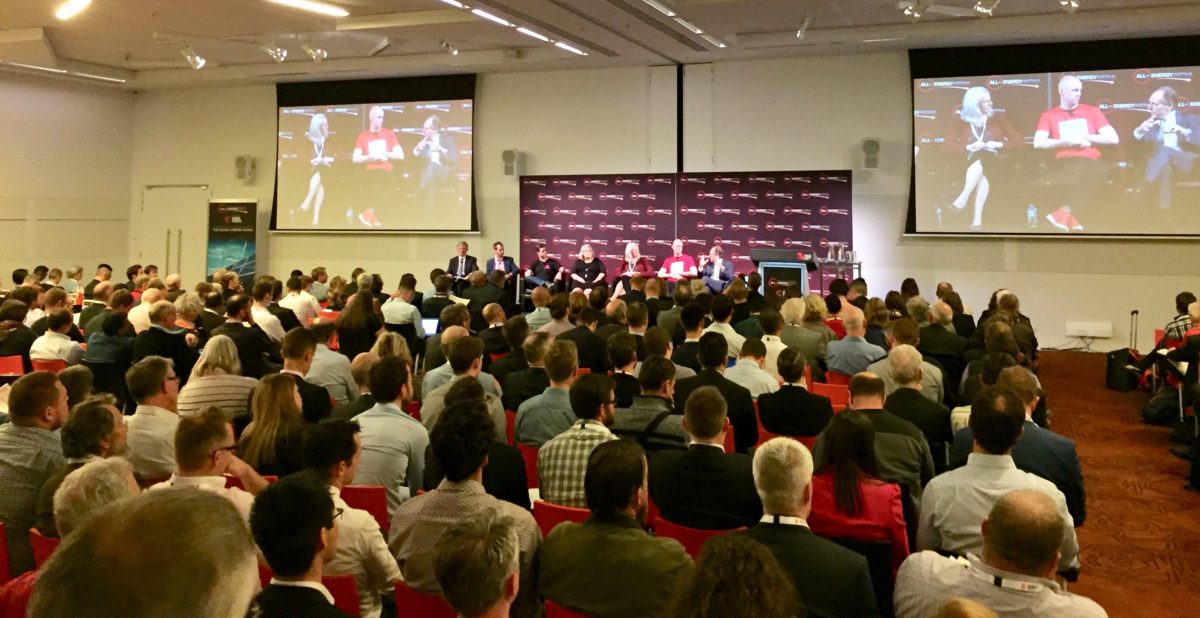All Energy Australia looks set to smash all previous attendance levels. While in 2016, around 5,000 renewable professionals took part in the event across two days, by 2pm today unofficial reports had 7,000 people attending the trade show and exhibition – and this is on the first day alone.
“It’s big and busy and people are happy,” summarised independent solar and storage analyst Warwick Johnston. “Yesterday at the Melbourne Cricket Ground there was a supply partners’ event and as I went up the escalators to the Members’ Dining Room, there was a steadily growing buzz. It was the people from the solar industry on the eve of the event and everyone was excited.”
Johnston, the founder of SunWiz, reported that solar industry participants right across the supply chain “are experiencing success again,” after a number of lean years only three or four years ago.
“Business is very good for everyone at the moment,” added Tristan Edis, the Director – Analysis and Advisory at Green Energy Markets. “But there is a lot of nervousness about the future as people can see that the RET driving tremendous [installation] figures in the utility scale sector is not going to last forever.”
Edis said that the policy mechanism by which sales and volumes beyond 2020, when the Renewable Energy Target comes to an end, is still missing at this point. “There are a lot of clouds there in the future.”
However, at present, both Edis and Johnston concur that currently for both the solar and battery storage it is close to being the best of times.
“There is more work than there are people to do it [at present],” Edis said. “In the rooftop sector the feeling is that this place has recovered its mojo.”
The drivers of the robust rooftop market segment, which Edis tips to exceed 1 GW in 2017, are retail electricity hikes that came into effect half way through this year, alongside the prominent place energy prices, and the surrounding debate over energy policy, currently has in the Australian media.
“This Federal Government decided to make an issue out of power reliability and power costs,” said Edis. “That then drives the media, who follow the government rhetoric, and then it was backed up by the reality of power prices going up.” He notes that while substancial on a percentage basis, in real dollar terms the increases were not completely onerous.
Regardless, households have been turning to rooftop PV in large numbers – in a situation that appears somewhat counterproductively for a government looking to support coal-fired generators.
The Australian commercial and industrial (C&I) market segment is also fast growing in both significance and volume.
“For commercial and industry [electricity consumers], which don’t pay as large network charges [as residential customers], the surge in the wholesale price – which has doubled – has cause alarm bells to go off in board rooms. Today, C&I represents about one-third of the market on a steady basis. That is quite significant given that the market has grown from under 800 MW in 2015, up to 800 MW [in 2016], to a bit over 1 GW in rooftop.”
Specifically addressing storage, Johnston said that there is a lot of interest from consumers in residential batteries, however he noted that there is still some way to travel for the installer community to effectively sell storage systems. “How to sell it? We’re still experimenting and people still don’t know how to do it yet.”
This content is protected by copyright and may not be reused. If you want to cooperate with us and would like to reuse some of our content, please contact: editors@pv-magazine.com.









By submitting this form you agree to pv magazine using your data for the purposes of publishing your comment.
Your personal data will only be disclosed or otherwise transmitted to third parties for the purposes of spam filtering or if this is necessary for technical maintenance of the website. Any other transfer to third parties will not take place unless this is justified on the basis of applicable data protection regulations or if pv magazine is legally obliged to do so.
You may revoke this consent at any time with effect for the future, in which case your personal data will be deleted immediately. Otherwise, your data will be deleted if pv magazine has processed your request or the purpose of data storage is fulfilled.
Further information on data privacy can be found in our Data Protection Policy.